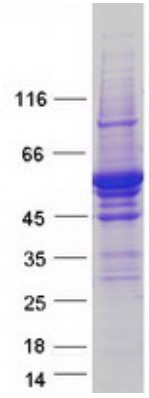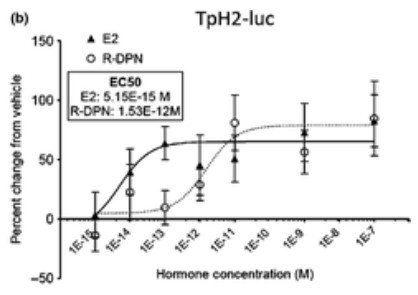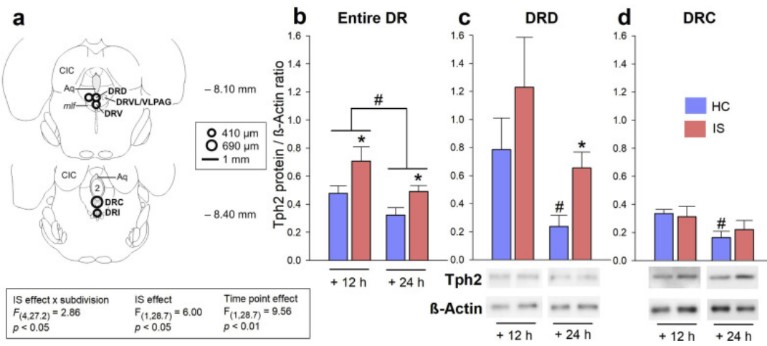Tph2
-
Official Full Name
tryptophan hydroxylase 2
-
Overview
Tryptophan Hydroxylase (TPH) belongs to the biopterin-dependent aromatic amino acid hydroxylase family. This enzyme catalyzes the first and rate limiting step in the biosynthesis of serotonin. Mutations in this gene have been implicated in a variety of di -
Synonyms
TPH2; tryptophan hydroxylase 2; tryptophan 5-hydroxylase 2; FLJ37295; NTPH; tryptophan 5-monooxygenase 2; neuronal tryptophan hydroxylase; ADHD7; MGC138871; MGC138872;
- Recombinant Proteins
- Cell & Tissue Lysates
- Protein Pre-coupled Magnetic Beads
- Chicken
- Homo sapiens (Human)
- Human
- Mouse
- Rat
- Rhesus Macaque
- Zebrafish
- E.coli
- E.coli expression system
- HEK293
- HEK293T
- Mammalian Cell
- Mammalian cells
- Flag
- GST
- His
- His (Fc)
- Avi
- His|GST
- Myc
- DDK
- Myc|DDK
- N/A
- N
- Background
- Quality Guarantee
- Case Study
- Involved Pathway
- Protein Function
- Interacting Protein
- Tph2 Related Articles
- Tph2 Related Research Area
What is TPH2 protein?
Tryptophan Hydroxylase 2 (TPH2) plays a substantial role in numerous biological mechanisms.The journal Science made the first credible reference to the TPH2 protein in 2003, describing it as an isoform of the Tryptophan Hydroxylase (TPH) gene. It was an exciting discovery as TPH1, the first isoform, was much known, whereas TPH2 was completely unheard of before 2003. It was Walther and Bader who found this novel isoform and describe it as being expressed predominantly in the brain, mainly in serotonergic neurons of the raphe nuclei.
Located on chromosome 12q21.1, TPH2 spans around 93.4 kilobases in humans, with 11 exons. The protein structure of TPH2 is intricate, having a tetramer structure with four identical subunits. Each subunit consists of three domains: an N-terminal regulatory domain, a central catalytic domain, and a C-terminal tetramerization domain. The uniqueness of TPH2 resides significantly in its detailed structured making it an ideal target for various drug design studies.
What is the function of TPH2 protein?
As an enzyme, TPH2 catalyzes the conversion of the amino acid tryptophan to 5-hydroxytryptophan (5-HTP) in the biosynthetic pathway of serotonin (5-HT). Serotonin, a well-known neurotransmitter, is significantly involved in various human body functions, ranging from mood regulation, sleep, appetite, to body temperature and pain perception. It is the exclusive enzyme for serotonin synthesis within the neurons of the central nervous system. Therefore, TPH2 plays a crucial role in maintaining serotonin levels in the brain.
TPH2 Protein-related Signal Pathway
The signal pathway associated with TPH2 is mainly the Serotonin Synthesis Pathway. TPH2 catalyzes the rate-limiting step in this pathway. The conversion of tryptophan to 5-HTP by TPH2 is an initial and significant step in the serotonergic pathway. Thereafter, the enzyme aromatic L-amino acid decarboxylase (AADC) converts 5-HTP into serotonin.
TPH2 Protein-related Diseases
The TPH2 protein and its functionality have been associated with various diseases. The most prominent of these diseases include psychiatric disorders like depression, anxiety, obsessive-compulsive disorder (OCD), and schizophrenia. These disorders have been observed in individuals carrying a gene variant of TPH2, promoting the disruption of TPH2 functionality and resulting in reduced serotonin levels in the brain. Consequently, this decrease leads to mood changes and other symptoms notable within the mentioned disorders.
Moreover, TPH2 is also associated with autism spectrum disorder (ASD), bipolar disorder, posttraumatic stress disorder (PTSD), and the Parkinsonian disorder. The correlation between TPH2 and these diseases is primarily established given the role TPH2 plays in serotonin production, a neurotransmitter essential for neuro-development, mood modification, and effective neurotransmission.
- Major Depressive Disorder (MDD): Reduced levels of serotonin, resulting from Tph2 dysfunction, have been implicated in the development and progression of MDD. Serotonin is an important neurotransmitter that regulates mood, and alterations in its levels can lead to depressive symptoms.
- Anxiety Disorders: Similar to MDD, dysregulation of serotonin due to Tph2 dysfunction has also been linked to various anxiety disorders, such as generalized anxiety disorder, panic disorder, and social anxiety disorder. Serotonin plays a crucial role in modulating anxiety levels and its imbalance can contribute to the development of anxiety disorders.
- Obsessive-Compulsive Disorder (OCD): Tph2 dysfunction has been implicated in OCD, a disorder characterized by unwanted and intrusive thoughts (obsessions) and repetitive behaviors (compulsions). Serotonin is involved in regulating the neural circuits associated with OCD symptoms, and alterations in serotonin levels can contribute to the development of these symptoms.
- Major depressive disorder: Serotonin deficiency is believed to contribute to the development of depression. Studies have shown that variations in the TPH2 gene can affect serotonin levels and increase the risk of developing depression.
- Anxiety disorders: Similar to depression, serotonin imbalance is also implicated in anxiety disorders. Dysregulation of TPH2 gene expression or activity may contribute to an increased susceptibility to anxiety disorders.
- Autism spectrum disorders (ASD): Serotonin is involved in neuronal development and synaptic transmission, both of which are implicated in ASD. Abnormalities in TPH2 gene function has been found in individuals with ASD, suggesting a potential role in the pathogenesis of the disorder.
Given the involvement of TPH2 in various disease processes, it has numerous applications in medical research and treatment strategies. Its primary relevance is seen in neuropsychiatric disorders where dysregulated serotonergic transmission is considered to underline the pathophysiology of these disorders.
TPH2 inhibitors and activators, when developed and studied meticulously, can hold significant therapeutic potential in managing disorders associated with the serotonergic system. Drug design studies targeting the unique molecular structure of TPH2 are crucial for improving the effectiveness of treatment strategies for common psychiatric disorders such as depression, schizophrenia, ADHD, and anxiety disorders.
- Major depressive disorder: Serotonin deficiency is believed to contribute to the development of depression. Studies have shown that variations in the TPH2 gene can affect serotonin levels and increase the risk of developing depression.
- Anxiety disorders: Similar to depression, serotonin imbalance is also implicated in anxiety disorders. Dysregulation of TPH2 gene expression or activity may contribute to an increased susceptibility to anxiety disorders.
- Autism spectrum disorders (ASD): Serotonin is involved in neuronal development and synaptic transmission, both of which are implicated in ASD. Abnormalities in TPH2 gene function has been found in individuals with ASD, suggesting a potential role in the pathogenesis of the disorder.
High Purity

Fig1. SDS-PAGE (Cat. No.: TPH2-2024H)

(Ryoko Hiroi, 2013)
Fig2. 17β-estradiol (E2) and R-diarylpropionitrile (R-DPN) time- and dose-dependently increase tryptophan hydroxylase-2 promoter cloned into the luciferase reporter vector (TPH2-luc) activity. (b) Dose response curves for ligand regulation of TPH2-luc (b) and ERE-luc activity.

(Nina C. Donner, 2013)
Fig3. Effects of inescapable tail shock (IS) on Tph2 protein expression 12 h and 24 h after IS. (a) Representative rostrocaudal bregma levels of the microdissection atlas used to sample anatomical subdivisions of the dorsal raphe nucleus (DR) in the rat brainstem for Experiment 2. (b, c, and d) Tryptophan hydroxylase 2 (Tph2) protein expression in (b) the entire DR (subdivisions averaged), (c) the dorsal part of the dorsal raphe nucleus (DRD), and (d) the caudal part of the dorsal raphe nucleus (DRC) either 12 h or 24 h after the onset of IS, compared to home cage (HC) control conditions (HC/12 h, n = 8; IS/12 h, n = 8; HC/24 h, n = 8; IS/24 h, n = 8). Below (c) and (d), representative, inverted chemoluminescence photomicrographs of significant IS- or diurnal rhythm-induced changes of Tph2 protein expression. Beta-actin (β-Actin) was used as the loading control during the western blot assay.
Tph2 involved in several pathways and played different roles in them. We selected most pathways Tph2 participated on our site, such as Amine-derived hormones, Metabolic pathways, Metabolism, which may be useful for your reference. Also, other proteins which involved in the same pathway with Tph2 were listed below. Creative BioMart supplied nearly all the proteins listed, you can search them on our site.
| Pathway Name | Pathway Related Protein |
|---|---|
| Amine-derived hormones | CGA;TPH2;DIO2;DBH;DDC |
| Metabolic pathways | PGD;ALG5;ALP3;RDH8B;COX6B1;MBOAT2;CYP2C54;NT5C1B;Amy1 |
| Metabolism | AQP1A.1;NUDT10;UPP2;SLC25A15B;GC;PDP1;SLC27A2;ARL2BP;COX11 |
| Metabolism of amino acids and derivatives | AZIN1A;SLC25A2;NAALAD2;SAT1B;SLC6A8;NQO1;AHCY;AZIN1B;SLC6A7 |
| Monoamine Transport | SYN1;HRH3;SCAMP2;DBH;UNC13B;TPH2;FBXO32;TGFB1I1 |
| SIDS Susceptibility Pathways | FOXM1;TPH2;SNTA1;TSPYL1;RUNX3;SST;POU3F2;PKNOX1;CTCF |
| Serotonergic synapse | PLCB2;PLCB4;Casp3;TPH2;PRKACG;CYP2C39;MAOA;CYP4X1;SLC18A1 |
| Serotonin Transporter Activity | SCAMP2;TPH2;TGFB1I1 |
Tph2 has several biochemical functions, for example, amino acid binding, iron ion binding, tryptophan 5-monooxygenase activity. Some of the functions are cooperated with other proteins, some of the functions could acted by Tph2 itself. We selected most functions Tph2 had, and list some proteins which have the same functions with Tph2. You can find most of the proteins on our site.
| Function | Related Protein |
|---|---|
| amino acid binding | OTC;TH;AARS2;PAH;SHMT2;TPH1A;TPH2;AGXT;DPYS |
| iron ion binding | TPH1B;CYP4F18;CYGB2;CYP51A1;CYP4Z1;SC5DL;CYP1A;LEPRE1;TMEM195 |
| tryptophan 5-monooxygenase activity | TPH2;TPH1B;TPH1;TPH1A;TH2 |
Tph2 has direct interactions with proteins and molecules. Those interactions were detected by several methods such as yeast two hybrid, co-IP, pull-down and so on. We selected proteins and molecules interacted with Tph2 here. Most of them are supplied by our site. Hope this information will be useful for your research of Tph2.
YWHAE
- Q&As
- Reviews
Q&As (5)
Ask a questionTargeting TPH2 through pharmacological agents or gene therapies may be explored to modulate serotonin levels and alleviate mood disorders.
TPH2 dysregulation may lead to imbalances in serotonin, contributing to the pathogenesis of anxiety disorders.
TPH2 has been studied in the context of neurodegenerative disorders due to its influence on serotonin, which has neuroprotective properties.
Yes, drugs targeting TPH2 or the serotonin pathway are being investigated for their potential in developing novel psychiatric medications.
Yes, genetic variations can affect TPH2 expression, contributing to individual differences in serotonin levels and susceptibility to mood disorders.
Customer Reviews (3)
Write a reviewIts consistent and accurate results, combined with its compatibility with various cutting-edge techniques, ensure that data collection and analysis are both reliable and meaningful.
The TPH2 protein's exceptional performance in ELISA and its successful application in protein electron microscopy structure analysis make it a highly reliable and recommended choice for researchers.
The manufacturer's commitment to delivering a high-quality product further enhances its reputation and guarantees its suitability for a wide range of research applications.
Ask a Question for All Tph2 Products
Required fields are marked with *
My Review for All Tph2 Products
Required fields are marked with *


